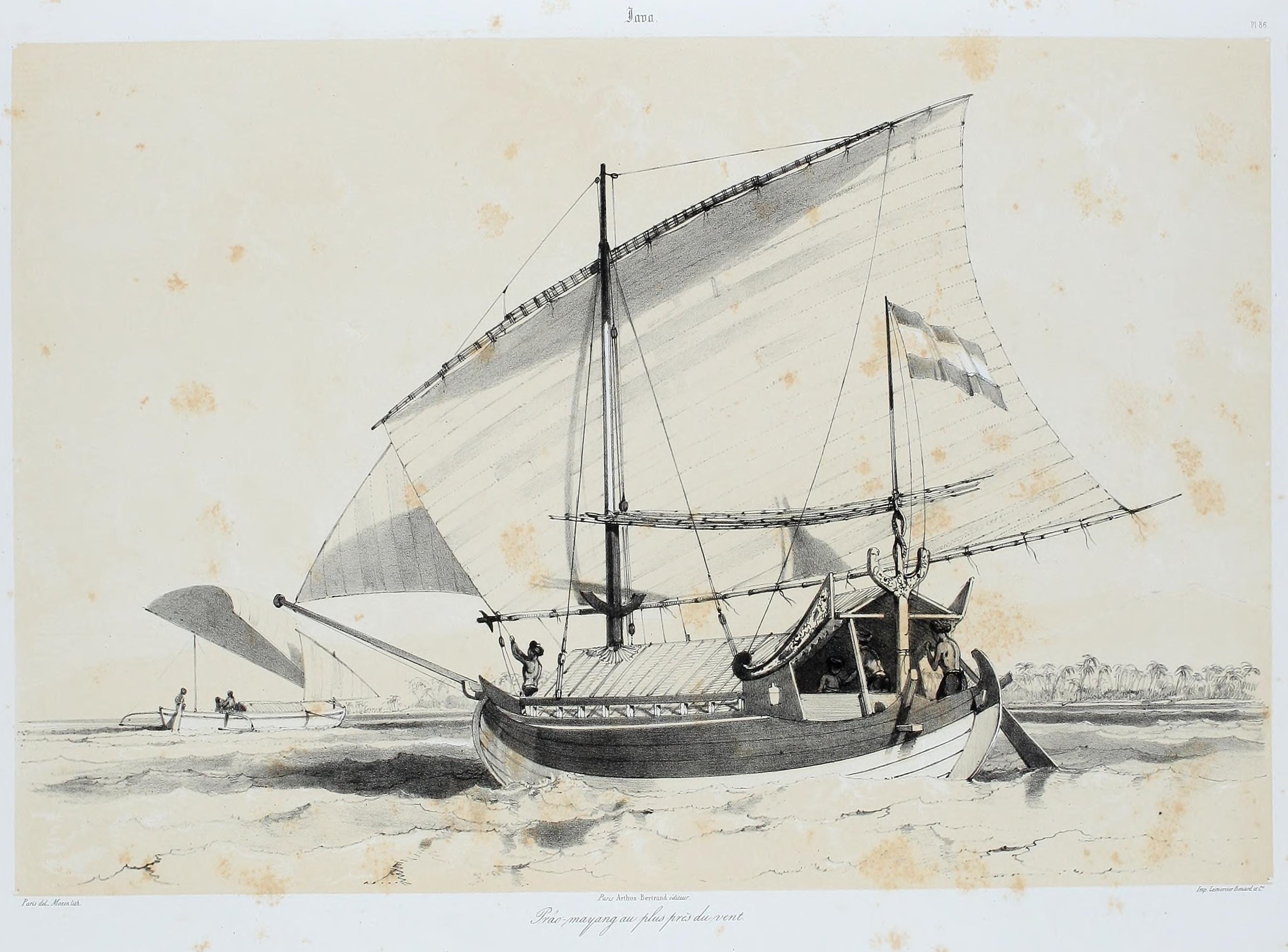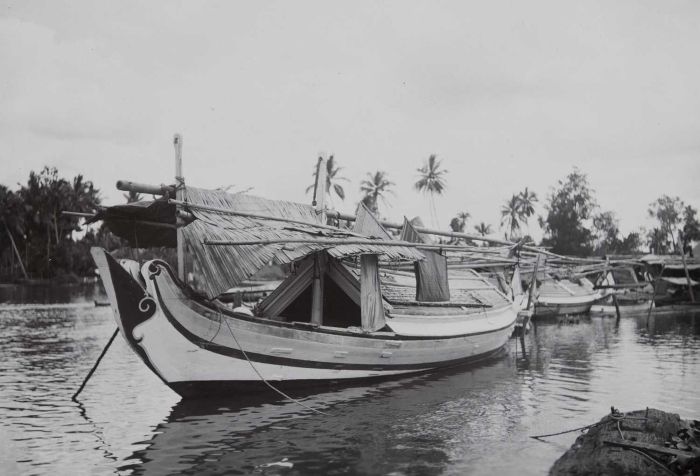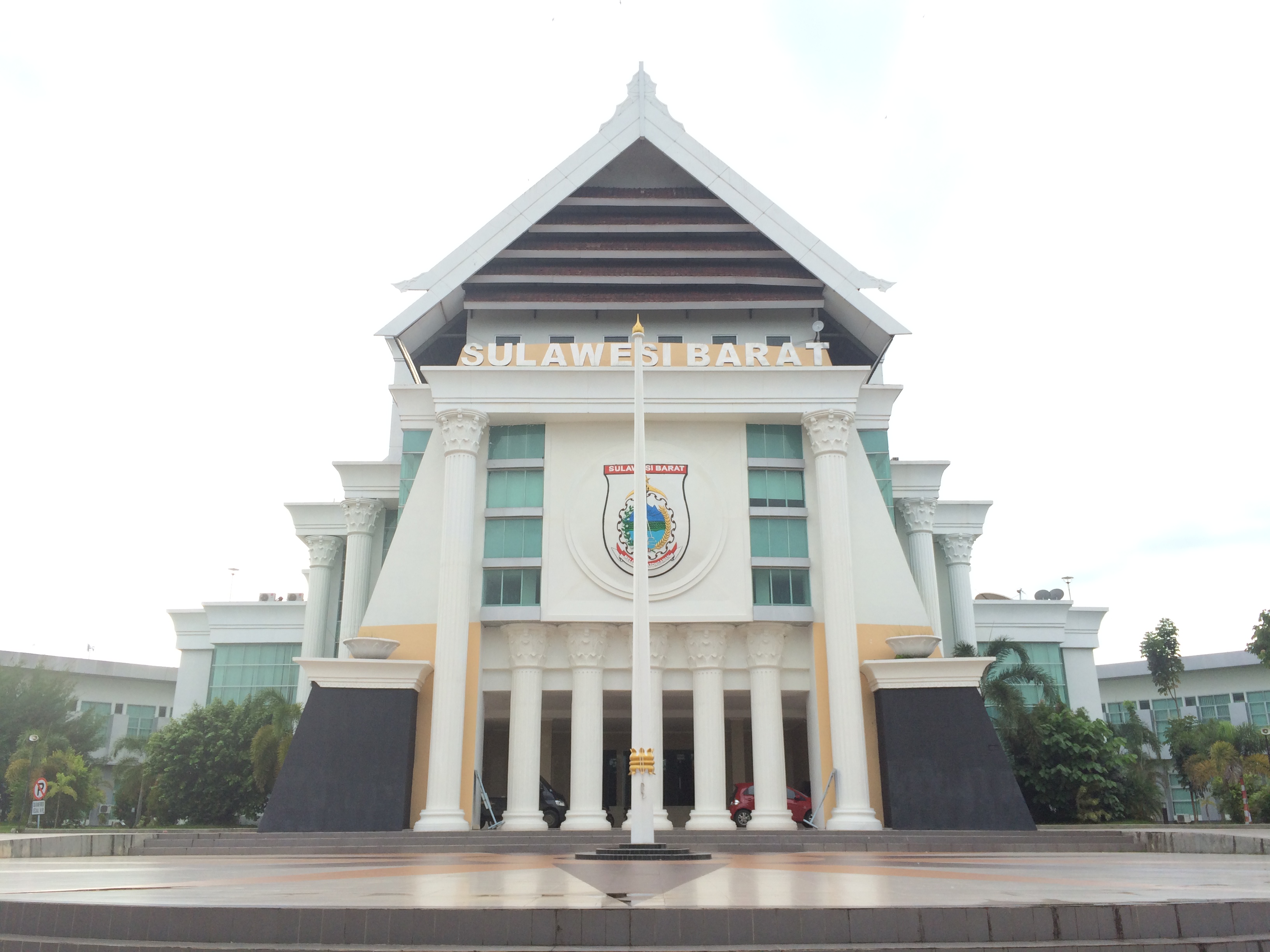|
Leti Leti
Leti leti is a type of traditional transport vessel from East Madura, Indonesia, especially from the administrative district of Sumenep. The leti leti is a recent development, the hull form and sail were developed in the 19th century. In 1979 sailing leti leti was numbered about 1000, but this was reduced in the next decades when more modern, motorized vessel appeared.Horridge (2015). p. 82. Etymology Leti leti is also known with other names and pronunciation, like leti-leti, letelete, lete lete, letek-letek, leteh-leteh, parao lete', and golekan lete. The origin of the name is unknown. In early 20th century the type was referred to in different publications as ''tekletek''. This is however the same name, with the first syllable dropped: 'le'''tek-letek'', as in 'a'''lisalis''. It may also possible that the name comes from the sail it used, the Madurese crab claw sail, or lete sail, which has just developed in the 19th century. In fact, the "lete" from lete sail is a local pronu ... [...More Info...] [...Related Items...] OR: [Wikipedia] [Google] [Baidu] |
Kupang
Kupang ( id, Kota Kupang, ), formerly known as Koepang, is the capital of the Indonesian province of East Nusa Tenggara. At the 2020 C ensus, it had a population of 442,758; the official estimate as at mid 2021 was 455,850. It is the largest city and port on the island of Timor, and is a part of the Timor Leste-Indonesia-Australia Growth Triangle free trade zone. Geographically, Kupang is the southernmost city in Indonesia. History Early history and Portuguese domination Kupang was an important port and trading post during the Portuguese and Dutch colonial eras. There are still ruins and remnants of the colonial presence in the city. Representatives of the Dutch East India Company (VOC) first encountered Kupang in 1613 after having conquered the Portuguese fort on the island of Solor. At this time the area of the city was governed by a Raja of the Helong tribe, who claimed descent from the island of Ceram in the Maluku archipelago. Kupang occupied an ideal strategic ... [...More Info...] [...Related Items...] OR: [Wikipedia] [Google] [Baidu] |
Pencalang
Pencalang is a traditional merchant ship from Nusantara. Historically it was called as pantchiallang or pantjalang. It was originally built by Malay people from the area of Riau and the Malay Peninsula, but has been copied by Javanese shipwrights.Liebner, Horst H. (2016). ''Beberapa Catatan Akan Sejarah Pembuatan Perahu Dan Pelayaran Nusantara''. Jakarta: Indonesian Ministry of Education and Culture. By the end of the 17th century this ship has been built by Javanese and Chinese shipbuilders in and around Rembang. However it was a popular choice for Balinese skippers followed by Sulawesian skippers. Etymology The word ''pencalang'' comes from Malay word, which has now been absorbed into Indonesian language, namely ''calang'' and ''mencalang'', which means "to scout", "to recon", and "to peek". Therefore, pencalang can be interpreted as "a boat used for spying" or "recon boat". According to VOC glossarium, the Malay word ''pentjalang'' means "ship that was sent on the lookout", fr ... [...More Info...] [...Related Items...] OR: [Wikipedia] [Google] [Baidu] |
Mayang (boat)
Perahu Mayang or simply mayang is a type of fishing boat from Java, Indonesia. This type of boat is used mainly for fishing and trading. Historically, this indigenous vessel is also favored by European skippers and private merchants for trading in East Indies: 50% of them were using mayang and pencalang. It is mostly used in northern coast of Java. The major production site is in Rembang, Central Java. Etymology The name mayang comes from ''payang'' (a type of seine) used by local fishermen. Thus the name can be translated as "using ''payang''". Description Major portion of the mayang hull is built using teak wood. The hull shape is broad, flat-bottomed with a pronounced bow and stern. It is deckless, but may have a covered "house" in the middle of the boat. Mayang are also built with a watertight bulkhead. In the 18th century, a Mayang is described as having a crew of 6 or 9 and is 12.2 to 15 metres long; with a 7.24 tonne burthen. A boat from 1850 had a beam of 3 m, a lengt ... [...More Info...] [...Related Items...] OR: [Wikipedia] [Google] [Baidu] |
Golekan
Golekan is a type of traditional boat from Madura, Indonesia. They once plied as far as Singapore, where they are referred to as Madurese traders. In the present this type of boat is only known locally, especially near Bangkalan in Western Madura and around the Kangean islands.Horridge (2015). p. 79. Etymology Dutch observer van Deventer wrote that it means "freight seeker". Gibson-Hill stated the name comes from Malay word ''golek'', which he claimed meant crank (tender, or 'tippy') when applied to a canoe. Rather, the name derived from ''kolek'', a Javanese word for 'boat', applied to a wide range of small craft along the north coast of Java. Thus the name ''golekan'' would meant 'a kind of ''kolek'''.Stenross (2007). p. 275. Golekan in Madurese culture were regarded as "male", being referred to as ''parao laki'' (male boat), so it has different ornamental motif from lis-alis and janggolan (''parao bini'' — female boat). The primary symbol was the rooster, associated in Indon ... [...More Info...] [...Related Items...] OR: [Wikipedia] [Google] [Baidu] |
Janggolan
Janggolan refers to two different type of ''perahu'' from Indonesia. One is from Madura, and the other from Bali. The Madurese janggolan is a type of indigenously constructed boat, meanwhile Balinese janggolan is an indigenous boat with western-styled hull construction. Madurese janggolan Janggolan in Madura comes from the western half of the south coast of Madura, from Kamal to Sampang. It is the largest from the family of boats with double stempost, like lis-alis. They can be found plying to Singapore in the past, being called "old-style golekkan". Etymology The word ''janggolan'' means transportation.Horridge (2015). p. 69. It is also called as ''parao janggol'' (meaning "transport perahu") by the Madurese. Like the alisalis, janggolan were regarded as "female" (''parao bini'' — female boat), and ornamental motif used were connected with the feminine.Stenross (2007). p. 277. Description Madurese janggolan can be identified by flat decorated face between the double stemp ... [...More Info...] [...Related Items...] OR: [Wikipedia] [Google] [Baidu] |
Lis-alis
Lis-alis is a type of traditional boat of Madura, Indonesia. Lis-alis usually present in canals that provide salt evaporation service in southern part of Madura and around Surabaya. Until the present, lis-alis remained overwhelmingly popular as a fishing craft in Bangkalan and Sukolilo, while a larger version, the '' kroman'', has been used in this area for at least a century for inshore transport work. Etymology It is also known as alisalis or alis alis. The name come from Indonesian word ''alis'' which means "eyebrows". This may refer to an ornamental motif which does resemble a pair of eyebrows, often applied to the top of the bow. Eyebrows are an important aspect of feminine beauty in traditional Indonesian culture, and these boats strongly associated with the feminine — on the northwest coast they were commonly referred as ''parao bini'', which means "female boat". Description These boats come from varying size between 5 metres long to more than 10 metres. Usually the le ... [...More Info...] [...Related Items...] OR: [Wikipedia] [Google] [Baidu] |
Flores Sea
The Flores Sea covers of water in Indonesia. The sea is bounded on the north by the island of Celebes and on the south by Sunda Islands of Flores and Sumbawa. Geography The seas that border the Flores Sea are the Bali Sea (to the west), Java Sea (to the northwest), and the Banda Sea (to the east and northeast). The Indian Ocean and Savu Sea lie to the south, but are separated from the Flores Sea by various islands. Islands that border this sea are the Lesser Sunda Islands and Celebes (Sulawesi). Extent The sea is deep. The International Hydrographic Organization (IHO) defines the Flores Sea as being one of the waters of the East Indian Archipelago. The IHO defines its limits as follows: ''On the North.'' The South coast of Celebes Sulawesi">/nowiki> Sulawesi">/nowiki>Sulawesi">Sulawesi.html"_;"title="/nowiki>Sulawesi">/nowiki>Sulawesi/nowiki>_from_the_West_point_of_Laikang_Bay_()_to_Tanjong_Lassa_(120°28'E). ''On_the_East.''_The_Western_limit_of_the_Banda_Sea_betwee ... [...More Info...] [...Related Items...] OR: [Wikipedia] [Google] [Baidu] |
Centreboard
A centreboard or centerboard (US) is a retractable hull appendage which pivots out of a slot in the hull of a sailboat, known as a ''centreboard trunk'' (UK) or ''centerboard case'' (US). The retractability allows the centreboard to be raised to operate in shallow waters, to move the centre of lateral resistance (offsetting changes to the sailplan that move the centre of effort aft), to reduce drag when the full area of the centreboard is not needed, or when removing the boat from the water, as when trailering. A centreboard which consists of solely a pivoting metal plate is called a centerplate. A daggerboard is similar but slides vertically rather than pivoting. The analog in a scow is a bilgeboard: these are fitted in pairs and used one at a time. General History Lt. John Schank (c. 1740 – 6 February 1823) was an officer of the British Royal Navy and is credited with the invention of the centerboard. Schank, however, gave credit for the idea to British Brigadier General ... [...More Info...] [...Related Items...] OR: [Wikipedia] [Google] [Baidu] |
Masalembu Island
Masalembu is an island located in the Java Sea and is the largest island in the Masalembu Islands. It is administered by the Masalembu District of the Sumenep Regency which is centered on the island of Madura and is made up of two administrative villages of Sukajeruk and Massalima. Geography The island measures about 7 km west-east and 6 km north-south, with a total land area of 23.86 square kilometers. It is located halfway between Borneo and the island of Madura, with a distance of about 150 km from either. It is largely flat, with the highest elevation reaching 12 meters above sea level. The interior of the island has largely been taken over by local agriculture. The island has no natural surface freshwater sources and is reliant on groundwater. Demographics 18,485 individuals (Statistics Indonesia, 2015 estimate) live on the island in 9,158 households, and the population has a sex ratio of 98.19. Administratively, the locals live in two villages of Massalima (pop. 10,325) and ... [...More Info...] [...Related Items...] OR: [Wikipedia] [Google] [Baidu] |
West Sulawesi
West Sulawesi ( id, Sulawesi Barat) is a province of Indonesia. It is located on the western side of Sulawesi island. It covers an area of 16,787.18 km2, and its capital is Mamuju. The 2010 Census recorded a population of 1,158,651, while that in 2020 recorded 1,419,228. The province was established in 2004, having been split off from South Sulawesi. Geography The province is on the island of Sulawesi (formerly Celebes) and includes the regencies (''kabupaten'') of Polewali Mandar, Mamasa, Majene, Mamuju, Central Mamuju and Pasangkayu (formerly called North Mamuju), which used to be part of South Sulawesi. The area of the province is 16,787.18 km2. Economy Its economy consists mainly of mining, agriculture and fishing. Its capital is Mamuju. Archaeological findings On 11 December 2019, a team of researchers led by Dr. Maxime Aubert announced the discovery of the oldest hunting scenes in prehistoric art in the world which is more than 44,000 years old fr ... [...More Info...] [...Related Items...] OR: [Wikipedia] [Google] [Baidu] |
Bago (boat)
A bago is a traditional boat built by the Mandar people of Sulawesi, Indonesia. The hull is of the pajala-type, lightly built and allowing for shallow displacement. The boat is long, with the mast only making up a quarter of its length. A bago can be readily identified as Mandarese boat by its rudderpost style. Smaller-sized bagos are often used as fishing boats from which fishermen cast their nets. The Mandar people prefer using a bago over an outrigger canoe.Horridge (2015). p.53. In the present, small bagos are outfitted with a leti (lete) sail/rig, but not long ago, they had canted rectangular sails ( tanja rig). Bigger versions of the bago, also using the pajala-type hull, are sometimes built rather deep and round but without the angle at the end of the keel. These boats can be found all over Mandar coast. A type with nade sail, created the West Sulawesian lambo. Another type, with leti sail and Mandar-style flat-roofed deckhouse, may be mistaken as leti leti. There is not ... [...More Info...] [...Related Items...] OR: [Wikipedia] [Google] [Baidu] |






_atau_Jabaran.png)

